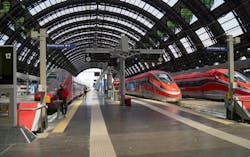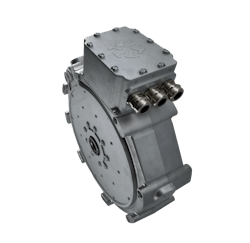Batteries, Brains and Blenders: Making Train Electrification a Reality in the UK
What does it take to power an electric train?
Batteries, brains, and a blender, according to Steve Hornyak, CEO of Turntide Technologies.
Turntide first came on the screen roughly a decade ago, originally as a combination of various acquisitions largely in the northern United Kingdom. The company was put together under the premise of green electrification and focused on three tenets of electrification.
“So, the batteries are your energy storage platform, the brains are your power electronics, and the blender is your axial flux motor,” Hornyak said. “The combination of those forming an incredible electrification platform.”
But unlike many companies, Turntide’s major market isn’t mass consumer vehicles like passenger cars. Instead, Turntide was built for “off-road” customers in different sectors including agriculture, marine, and the military. In July, the company announced a deal where Turntide will supply Hitachi Rail with Gen 2 lithium iron phosphate (LFP) battery systems for its Grand Central intercity battery train contract with Arriva Trains in the U.K.
Hitachi Rail initially won the contract to build nine battery intercity (tri-mode) trains for Arriva’s Grand Central and Angel Trains back in April. These will be the first new battery trains manufactured in the U.K. Turntide has been involved with Hitachi Rail since roughly 2020, and Hornyak said this most recent partnership is the culmination of years of “strategic work” together on electrifying passenger rail.
Fresh off the announcement, Hornyak sat down with EnergyTech for an interview about the business of building (and charging) electric trains, hybridization, and more. (Answers may have been edited for clarity).
Q: How do trains in the UK operate?
They'll typically be three trains or cars that are put together and each one of those has its independent traction system and diesel system in it. Today, those diesel systems are complex, heavy, fuel-intensive, stinky, and take a lot of maintenance.
Q: Where does Turntide come in?
We're providing the battery system. The propulsion systems are incredibly large powerful systems beyond what Turntide does. Each one of these motors or cars can move the train without the other two, so they can operate independently or in conjunction with each other.
Not all areas of rail in UK are electrified, but parts of them are to where you can get overhead power so you can charge in motion. It's also great for regenerative braking; trains start and stop a lot, and when they stop, they can create a ton of regenerative energy. Then also when you pull into areas of high congestion, you can go full electric so that you're not producing any exhaust.
Q: How does the Hitachi deal work?
“Before this deal, we got the first of these kinds of trains operating before the end of last year under the power of Turntide’s energy storage systems. Based on that success, Hitachi was able to get their first customer and in turn came to us with the agreement to take that initial product and scale it for rollout, initially in the UK.
Right now Hitachi is building new trains, bringing those to market and plugging them in. They have the option to make up to three cars as electric. They can do all-electric but they're not going to do that because it would have limited use cases. For the most part, the center car will be electric.
“Hitachi does operate trains as a service where the trains are not sold, they're provided as a service and part of that service is maintenance. The benefit to their customers is they get trains that are good for the environment and Hitachi is a lower cost of maintenance, just like an electric car is way lower to maintain, and those lower operating costs are for their ultimate customer: Rail operators.”
Q: Is there anything that particularly sets your batteries apart compared to rival technologies? Why did Hitachi go with Turntide?
“A number of reasons. But first, chemistry changes all the time; we're not doing anything different with LFP than others are. But we have done a couple of other things: You've got to be rail certified, and it’s a massive process. I don't know another vendor out there in our space that is rail certified.
“Number two: When you're moving these massive pieces of machinery, you need to have an energy management system for their big, dense battery packs. Not a battery management system, but an energy management system that is optimized for moving big pieces of metal with massive batteries while keeping them cool to maximize the longevity of the battery as well as the performance of the battery. There's a significant amount of engineering that is incredibly specific to moving massive things with massive batteries that are hyper differentiated by what Turntide has done in the rail market.”
Q: How does charging a train work?
“You can use regenerative braking; because the chains are so heavy when they come up and stop, they're basically collecting all that energy and sending it right back into the battery. You've also got overhead charging. There's a good portion of the rail out there today on some of the shorter runs, mainly inner city and around some towns, where you can put overhead charging in. So, you'll be charging on the fly.
“You can also charge overnight in depots when the rails aren't running. So you have a few different ways to charge them. With cars, you really only have one way, right?”
Q: Are there any unique challenges associated with electrifying trains?
“The big thing is the amount of safety, and scrutiny around safety, is massive. Making sure that these things are incredibly safe with tons of fail-safes on top of it. Not that safety isn't extreme in other areas but the size of the batteries and the amount of energy that those batteries store and produce for the propulsion needed to move these massive pieces of metal is unlike anything else that you typically do out there in the electrification sector. It’s created a whole set of issues on how to manage and optimize that energy.”
Q: Do you see hybrid trains becoming more popular in the US soon?
“The U.S. is watching, (and) so is Canada, so is Japan, and a number of other places. Right now, on the train side, particularly with Hitachi, the UK is ahead of everyone else. This is already a successful project, they're just in the process of rolling this out, which takes time. But I would absolutely see these same types of trains rolling out throughout the world over the coming 5 - 10 years.”
Q: Do you see hybridization as just the next step to full electrification?
“I'm an “and” person, not an “or” person. When we went from pure ICE to pure electrification, I never thought that it was going to work across the board. I think there was a big artificial push for that by the government and organizations, and it was financially supported by rules and regulations. And it wasn't just the US, but across the world.
“I believe that we are, we are now moving in the world of reality, where there are evolutions, revolutions and transformations. This is more of an evolution of a market where you're going to have multiple ways of moving things. ICE is going to be around for a long time and you've got a lot of applications where pure electrification is perfect, but on long haul trips, ICE is still a little better unless you're patient.
“I believe that across the board you're going to continue to see different percentages of ICE, pure EV and hybrids in a lot of applications. Hybrid is awesome for cost, weight, speed, and performance. Axial flux motors, what we're doing, are absolutely exploding.
“Outside the envelope of Hitachi, our Axial flux business is going off the chain, and a significant amount of that is for inline hybrid, where take an existing vehicle and shrink the engine so you've got enough room to put in these incredibly powerful, compact, energy efficient axial flux motors in liae with the axle so they can drive it by itself, in conjunction with the ICE motor, or let the ICE motor drive the car by itself.
“I think those types of applications we're seeing a ton in the recreation space and moving into the on-road application space. Ultimately, I think that'll trickle down into other areas. Imagine having a pickup truck that could go 1000 miles on a tank of gas and produce 1000 horsepower. It's possible with a diesel hybrid and the axial flux motor.”
About the Author
Jennifer Ramsay, Editor at Large, Market Moves Newsletter
Jennifer Ramsay serves as the Editor-At-Large for Endeavor Business Media’s Market Moves newsletter. A Georgia native, she holds a communications degree from the University of North Georgia and has been a journalist since 2019, reporting on a variety of topics.


